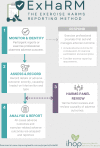Practical suggestions for harms reporting in exercise oncology: the Exercise Harms Reporting Method (ExHaRM)
- PMID: 36600391
- PMCID: PMC9743394
- DOI: 10.1136/bmjopen-2022-067998
Practical suggestions for harms reporting in exercise oncology: the Exercise Harms Reporting Method (ExHaRM)
Abstract
The volume of high-quality evidence supporting exercise as beneficial to cancer survivors has grown exponentially; however, the potential harms of exercise remain understudied. Consequently, the trade-off between desirable and undesirable outcomes of engaging in exercise remains unclear to clinicians and people with cancer. Practical guidance on collecting and reporting harms in exercise oncology is lacking. We present a harms reporting protocol developed and refined through exercise oncology trials since 2015.Development of the Exercise Harms Reporting Method (ExHaRM) was informed by national and international guidelines for harms reporting in clinical trials involving therapeutic goods or medical devices, with adaptations to enhance applicability to exercise. The protocol has been adjusted via an iterative process of implementation and adjustment through use in multiple exercise oncology trials involving varied cancer diagnoses (types: breast, brain, gynaecological; stages at diagnosis I-IV; primary/recurrent), and heterogeneous exercise intervention characteristics (face to face/telehealth delivery; supervised/unsupervised exercise). It has also involved the development of terms (such as, adverse outcomes, which capture all undesirable physical, psychological, social and economic outcomes) that facilitate the harms assessment process in exercise.ExHaRM involves: step 1: Monitor occurrence of adverse outcomes through systematic and non-systematic surveillance; step 2: Assess and record adverse outcomes, including severity, causality, impact on intervention and type; step 3: Review of causality by harms panel (and revise as necessary); and step 4: Analyse and report frequencies, rates and clinically meaningful details of all-cause and exercise-related adverse outcomes.ExHaRM provides guidance to improve the quality of harms assessment and reporting immediately, while concurrently providing a framework for future refinement. Future directions include, but are not limited to, standardising exercise-specific nomenclature and methods of assessing causality.
Keywords: ONCOLOGY; PUBLIC HEALTH; SPORTS MEDICINE.
© Author(s) (or their employer(s)) 2022. Re-use permitted under CC BY. Published by BMJ.
Conflict of interest statement
Competing interests: None declared.
Figures
References
Publication types
MeSH terms
LinkOut - more resources
Full Text Sources
Medical

